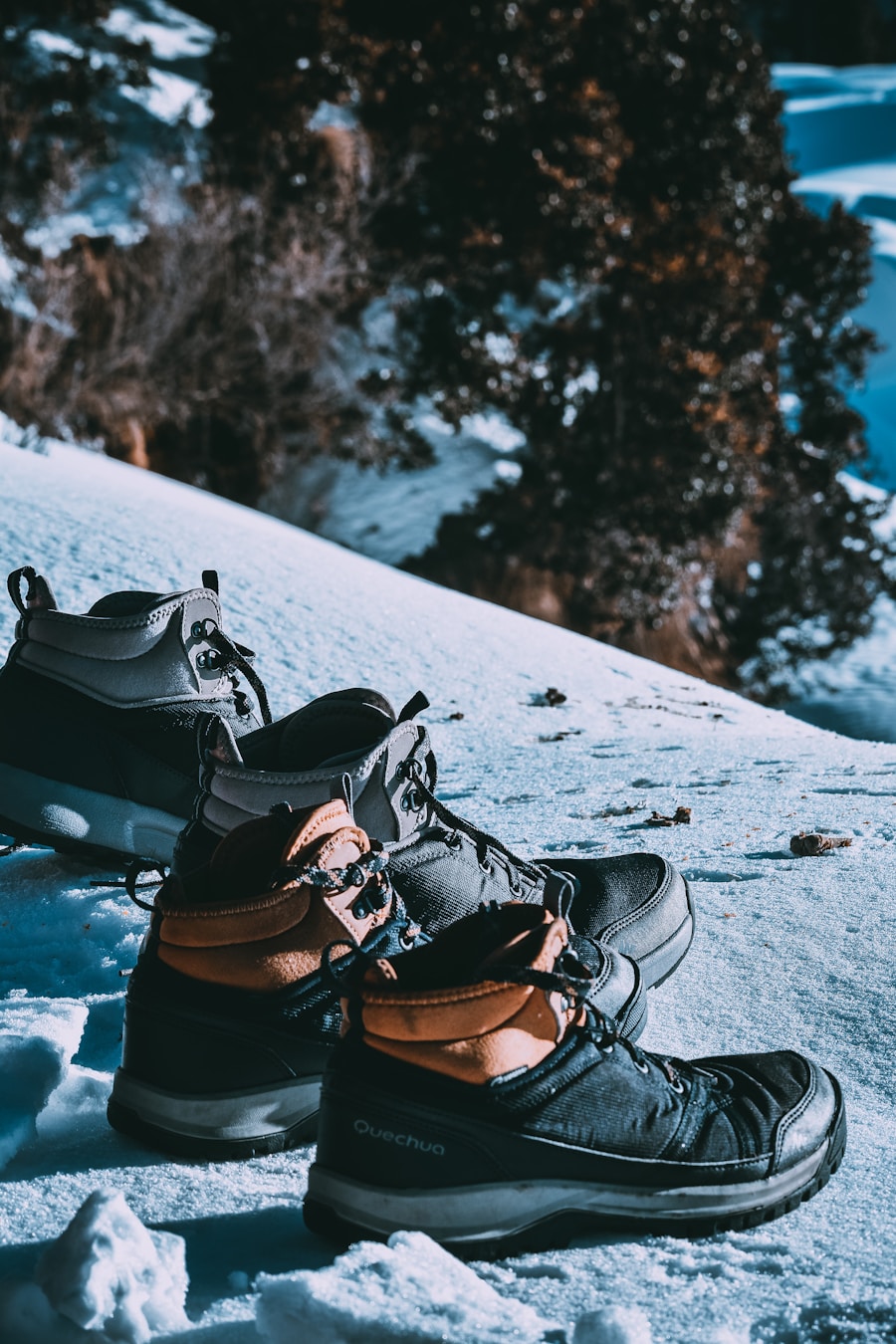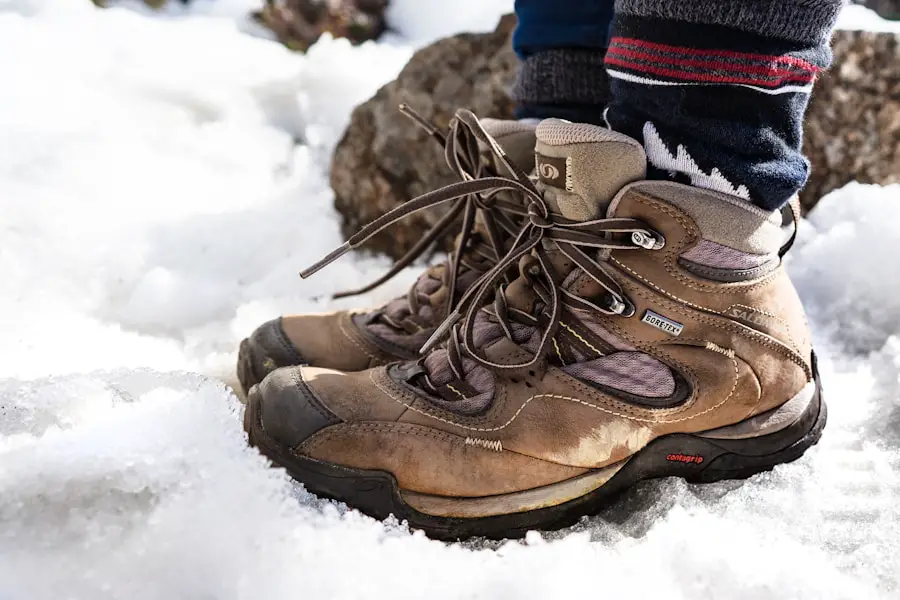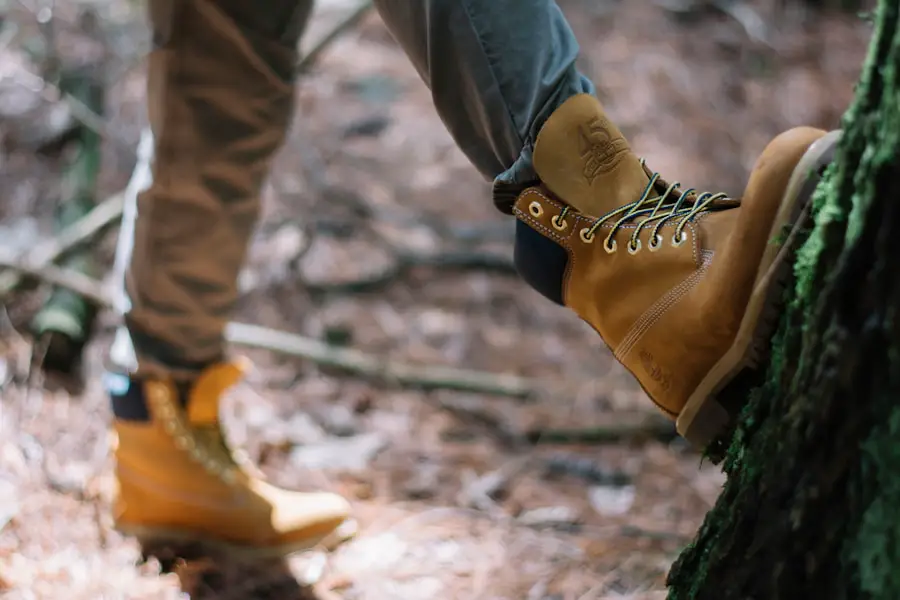The significance of a proper fit in hiking boots cannot be overstated. A well-fitted boot serves as the foundation for a successful hiking experience, providing the necessary support and comfort to navigate various terrains. When hiking, your feet endure a considerable amount of stress, and the right footwear can mitigate the risk of blisters, calluses, and other foot-related issues.
A boot that fits correctly allows for natural foot movement while ensuring that the heel is locked in place, preventing unnecessary slippage that can lead to discomfort and injury. Moreover, the importance of fit extends beyond mere comfort; it directly impacts performance. A boot that fits well enhances stability and traction, which are crucial when traversing uneven or slippery surfaces.
For instance, a hiker wearing boots that are too loose may find themselves struggling to maintain balance on rocky trails, while those with a snug fit can confidently navigate challenging paths. Therefore, investing time in finding the right fit is essential for both safety and enjoyment during outdoor adventures.
Key Takeaways
- Proper fit is crucial for comfort and performance in hiking boots
- Understanding sizing and width is essential for finding the right fit
- Trying on hiking boots in person is the best way to ensure a proper fit
- Factors to consider for a snug fit include heel hold, toe room, and overall comfort
- Breaking in hiking boots gradually can help customize the fit to your feet
Understanding Sizing and Width
Sizing and width are critical components in selecting the right hiking boots. Unlike regular shoes, hiking boots often come in various sizes and widths to accommodate different foot shapes. Standard sizing typically ranges from size 5 to size 15 for men and women, but many brands also offer half sizes to ensure a more precise fit.
Width is equally important; boots are generally available in narrow, regular, and wide options. Understanding these dimensions is vital for hikers who want to avoid discomfort during long treks. Foot shape varies significantly among individuals, which is why knowing your specific measurements can make a substantial difference.
For example, someone with a high arch may require a boot with more cushioning and support, while those with flat feet might benefit from a wider toe box to prevent pinching. Additionally, some brands have developed their own sizing systems, which can lead to confusion. It’s advisable to consult sizing charts provided by manufacturers and, if possible, try on multiple brands to find the best match for your unique foot shape.
Trying on Hiking Boots

Trying on hiking boots is an essential step in the selection process that should not be rushed. When testing boots, it’s crucial to wear the same type of socks you plan to use on your hikes, as this can significantly affect the fit. Thick or thin socks can alter how the boot feels on your foot, so bringing along your preferred hiking socks will provide a more accurate assessment.
Additionally, it’s best to try on boots later in the day when your feet are slightly swollen from daily activities; this mimics the conditions you’ll experience during a long hike. While trying on boots, pay attention to how they feel in various areas of your foot. The heel should fit snugly without lifting when you walk, while the toe box should allow for some wiggle room without excessive movement.
A good practice is to stand up and walk around in the boots for several minutes; this will help you gauge comfort levels and identify any pressure points. If possible, simulate hiking conditions by walking on inclines or declines within the store. This will give you a better sense of how the boots will perform on actual trails.
Factors to Consider for a Snug Fit
| Factors | Description |
|---|---|
| Head Circumference | The measurement around the widest part of the head, usually above the ears and eyebrows. |
| Helmet Size | The size of the helmet, usually measured in inches or centimeters, to ensure a proper fit. |
| Adjustment System | The presence of a dial or strap system to adjust the fit of the helmet to the wearer’s head. |
| Comfort Padding | The thickness and material of the padding inside the helmet for a comfortable and snug fit. |
| Chin Strap | The presence of a secure and adjustable chin strap to keep the helmet in place during activities. |
Achieving a snug fit involves considering several factors beyond just size and width. One critical aspect is the boot’s construction material. Leather boots tend to stretch over time, while synthetic materials may not offer the same level of give.
Therefore, it’s essential to choose a material that aligns with your intended use and comfort preferences. For instance, if you plan on hiking in wet conditions, waterproof materials may be necessary, but they might also require a more precise fit since they don’t stretch as much. Another factor is the boot’s design features, such as arch support and cushioning.
A boot with adequate arch support can help distribute weight evenly across your foot, reducing fatigue during long hikes. Additionally, consider the type of lacing system; some boots come with advanced lacing systems that allow for more precise adjustments around the ankle and instep. This feature can be particularly beneficial for hikers with narrower feet or those who require additional support around the ankle.
Breaking in Hiking Boots
Breaking in hiking boots is a crucial step that many hikers overlook. New boots often require a period of adjustment before they become comfortable enough for long hikes. This process allows the materials to soften and conform to the unique shape of your feet.
It’s advisable to start by wearing your new boots for short walks or light hikes before embarking on more strenuous adventures. Gradually increasing the duration and intensity of wear will help prevent blisters and discomfort during longer treks. During the break-in period, pay attention to any areas of discomfort or pressure points.
If you notice specific spots that cause irritation, consider using moleskin or blister pads to protect those areas while you continue to wear the boots. Additionally, some hikers find it helpful to wear their boots around the house or during everyday activities to expedite the breaking-in process. This not only helps soften the materials but also allows you to assess how well they perform in various situations.
Tips for Finding the Perfect Fit

Finding the perfect fit for hiking boots requires patience and attention to detail. One effective strategy is to visit specialty outdoor retailers where knowledgeable staff can provide guidance based on your specific needs and preferences. These experts often have experience with various brands and models and can recommend options that align with your foot shape and intended use.
Additionally, many stores offer fitting services that include measuring your feet accurately, which can help eliminate guesswork. Another tip is to consider trying on multiple pairs from different brands during your search. Each manufacturer has its own sizing nuances and design philosophies, which means that what works for one person may not work for another.
Don’t hesitate to explore various styles—such as low-cut versus mid-cut or lightweight versus heavy-duty—to find what feels best for you. Lastly, remember that comfort should always take precedence over aesthetics; even if a boot looks great, it won’t serve you well if it causes pain or discomfort on the trail.
Signs of a Poor Fit
Recognizing signs of a poor fit is essential for maintaining foot health during hikes. One of the most common indicators is discomfort or pain in specific areas of the foot after wearing the boots for a short period. If you experience pinching around the toes or excessive movement of your heel within the boot, these are clear signs that adjustments are needed or that you may need a different size or style altogether.
Blisters are another telltale sign; if you develop blisters after only a short hike, it’s likely that your boots do not fit properly. Additionally, if you find yourself constantly adjusting your laces or stopping frequently to relieve pressure points, this could indicate an ill-fitting boot. A well-fitted boot should feel secure without requiring constant readjustment.
If you notice that your feet feel fatigued or sore after hikes that previously felt manageable, it may be time to reassess your footwear choices. Ignoring these signs can lead to more severe issues such as tendonitis or plantar fasciitis over time.
Adjusting Lacing for a Customized Fit
Adjusting lacing techniques can significantly enhance the fit of your hiking boots, allowing for a more customized experience tailored to your foot shape and hiking style. The way you lace your boots can affect how they feel around your ankle and instep, providing additional support where needed. For instance, if you have narrow feet, consider using a technique called “heel lock” lacing, which involves creating extra tension around the ankle area by looping the laces through the top eyelets before tying them off.
This method helps secure the heel in place and reduces slippage during descents. Conversely, if you experience pressure on the top of your foot or have high arches, you might benefit from skipping one or two eyelets when lacing up. This technique allows for more room in the toe box while still providing adequate support around the ankle.
Experimenting with different lacing patterns can help you find what works best for your unique foot shape and hiking conditions. Ultimately, taking the time to adjust lacing can make a significant difference in overall comfort and performance on the trail.
When considering how snug hiking boots should be, it’s important to also take into account the terrain and weather conditions you’ll be facing on your trek. For more information on the best time to travel to Greece and make the most of your outdoor adventures, check out this seasonal guide. Understanding the climate and environment of your destination can help you choose the right gear, including properly fitting hiking boots, for a comfortable and enjoyable experience.
FAQs
What is the importance of having properly fitting hiking boots?
Properly fitting hiking boots are important for providing support, stability, and comfort while hiking. Ill-fitting boots can lead to blisters, hot spots, and even injuries.
How snug should hiking boots be?
Hiking boots should fit snugly around the heel and midfoot, with enough room in the toe box to wiggle your toes. They should feel secure and not allow for excessive movement or rubbing.
Should there be any extra space in hiking boots?
There should be a small amount of extra space in hiking boots to accommodate for foot swelling during long hikes. However, this extra space should not be excessive and should not allow for the foot to slide around inside the boot.
What are some signs that hiking boots are too snug?
Signs that hiking boots are too snug include pinching or pressure points, numbness or tingling in the toes, and discomfort while walking or hiking.
How can I ensure that my hiking boots fit properly?
To ensure proper fit, it is recommended to try on hiking boots with the socks you plan to wear while hiking, walk around in them to assess comfort and fit, and seek the assistance of a knowledgeable salesperson if possible.
